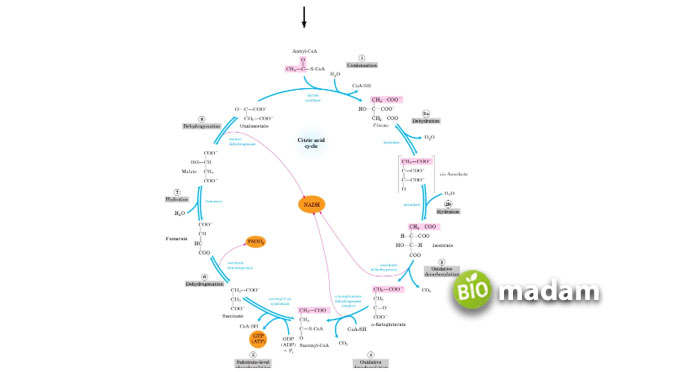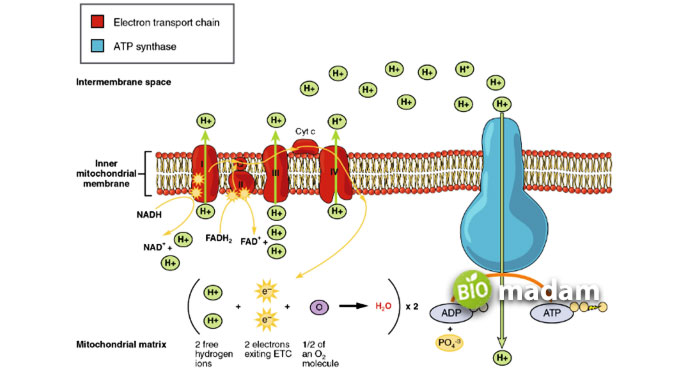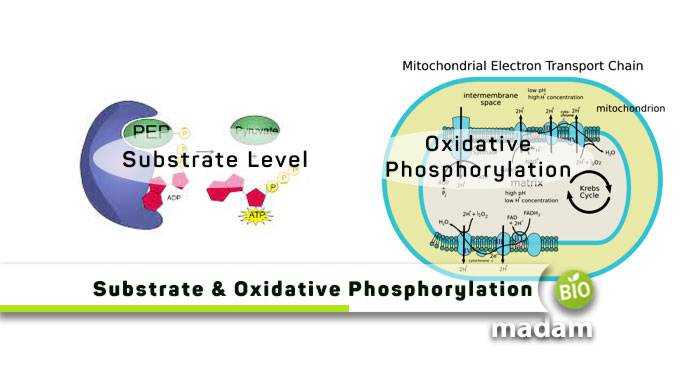All organisms, including prokaryotes and eukaryotes, exhibit respiration in one way or the other. Cellular respiration is one of the types of respiration that also involves phosphorylation. Organisms experience three phosphorylation types: substrate level, oxidative, and photophosphorylation. Of the three, substrate-level phosphorylation and oxidative phosphorylation are the most commonly studied.
Let’s tell you more about phosphorylation and all the differences between substrate level and oxidative phosphorylation.
Comparison Table
| Characteristics | Substrate Level | Oxidative |
| Definition | Direct transfer of phosphate group | Phosphorylation in the presence of oxygen |
| Location | Mitochondria & cytosol | Mitochondria |
| Energy Source | Coupled reaction | Electron transport chain |
| Oxygen Requirements | No | Yes |
| Occurrence | Glycolysis & Krebs cycle | Electron transport chain |
| Oxidation | Partial | Complete |
| NAHD2 Requirement | No | Yes |
| Oxidation/Reduction | NAD & FAD reduced | NADH+FADH+oxidized |
| ATPs produced | Four | Thirty four |
What is Phosphorylation?
Phosphorylation is a cellular biochemical process in which organic compounds like ADP or glucose receive a phosphate molecule. The addition of phosphate converts the ADP molecule into an ATP (adenosine triphosphate) molecule. ATPs are critical to providing energy to the cells to carry out various cellular processes. Many processes in the body, like apoptosis, depend on phosphorylation. Phosphorylation plays a significant role in various other activities in eukaryotic cells, including cell development, cell division, growth, and production of protein types.
Keep reading to learn more about substrate-level phosphorylation vs oxidative phosphorylation.
What is Substrate-level Phosphorylation?
Substrate-level phosphorylation is a process that occurs during glycolysis and the Krebs cycle, also known as the citric acid cycle. It takes place in order to form high-energy ATPs for cellular and biological processes in the body. The method may also use a Guanosine diphosphate (GDP) molecule to create GTP.
Enzymes and catalysts like kinases catalyze this direct transfer of phosphate groups. The breakdown of the phosphate group is an exothermic reaction and releases energy. This released energy eventually adds a phosphate group to the ADP. This phenomenon is called reaction coupling.
The process can be represented by:
1,3-bisphosphoglycerate + ADP → 3-phosphoglycerate + ATP
Glycolysis is a typical example of substrate-level phosphorylation in aerobic and anaerobic respiration. During glycolysis, glucose is broken down into two molecules of pyruvate. Along the way, specific intermediate molecules, such as glyceraldehyde-3-phosphate, donate phosphate groups to ADP, forming ATP. This direct transfer of a phosphate group from a substrate molecule to ADP is what characterizes substrate-level phosphorylation. On the other hand, Kreb’s cycle exhibits phosphorylation in the mitochondria. Here, the remaining carbon atoms from the original glucose molecule are further broken down, releasing energy-rich electrons and forming high-energy molecules like NADH and FADH2. These molecules then participate in the electron transport chain.

What is Oxidative Phosphorylation?
As the name indicates, oxidative phosphorylation occurs only in the presence of oxygen (aerobic conditions). It occurs in the inner mitochondrial membrane and involves the transfer of electrons from carrier molecules, such as NADH and FADH2, to molecular oxygen.
Oxidative phosphorylation transfers electrons through the electron transfer chain to phosphorylate ADP into ATP. ATP synthase enzyme and NADH electron carriers facilitate the transfer process to produce ATP. The energy comes from the electron transport chain, and phosphates enter the inorganic phosphate pool. Oxidative phosphorylation uses oxygen as the electron acceptor in the process, which is definitely contrary to substrate-level phosphorylation. This process yields more adenosine triphosphate molecules (26 ATPs per glucose molecule) in eukaryotes, aerobic archaea, and bacteria.

Oxidative phosphorylation takes place in both prokaryotic and eukaryotic organisms. The process occurs in the plasma membrane and mitochondria of the prokaryotes and eukaryotes, respectively.
Similarities Between Substrate-level Phosphorylation and Oxidative Phosphorylation
While you may have grabbed substrate-level and oxidative phosphorylation differences, we suggest you take a look at their common points, too:
- These processes take place in both eukaryotes and prokaryotes.
- They enable the production of ATP by transferring phosphate to ATP.
- Substrate level and oxidative phosphorylation involve enzymes as catalysts.
Differences Between Substrate Level and Oxidative Phosphorylation
Definition
Substrate-level Phosphorylation
Substrate-level phosphorylation is the process of directly transferring the phosphate group to the ADP to produce ATP.
Oxidative Phosphorylation
Oxidative phosphorylation, on the other hand, uses energy from chemical oxidation to carry out phosphorylation.
Location
Substrate-level Phosphorylation
Substrate-level phosphorylation occurs in a cell’s mitochondria and cytosol (also called cytoplasm).
Oxidative Phosphorylation
Opposed to the above, oxidative phosphorylation occurs in the mitochondria of cells.
Energy Source
Substrate-level Phosphorylation
This kind of phosphorylation uses energy from the coupled reaction.
Oxidative Phosphorylation
At the same time, oxidative phosphorylation obtains energy from the electron transport chain.
Oxygen Requirements
Substrate-level Phosphorylation
This phosphorylation process can occur in any area, whether aerobic or anaerobic.
Oxidative Phosphorylation
Contrarily, oxidative phosphorylation only occurs in an oxygen-rich (aerobic) environment.
Occurrence
Substrate-level Phosphorylation
Substrate-level phosphorylation occurs in the Krebs cycle and glycolysis.
Oxidative Phosphorylation
On the other hand, this phosphorylation reaction happens in the electron transport chain.
NADH2 Requirement
Substrate-level Phosphorylation
This process does not require energy in the form of NADH2 to produce ATPs.
Oxidative Phosphorylation
Yet, NADH2 is required for the formation of ATPs in oxidative phosphorylation.
Oxidation/Reduction
Substrate-level Phosphorylation
NAD and FAD are reduced during substrate-level phosphorylation.
Oxidative Phosphorylation
Contrarily, oxidative phosphorylation oxidizes NADH+ and FADH+.
ATPs Produced
Substrate-level Phosphorylation
Substrate-level phosphorylation produces four ATPs at the end of one cycle.
Oxidative Phosphorylation
Oxidative phosphorylation gives rise to thirty-four ATPs at the end.
The Bottom Line
Regarding substrate-level vs oxidative phosphorylation, the two take place differently despite being the phosphorylation types. They enable the production of ATPs by transferring phosphate groups to ADPs. ATPs are critical energy sources required to carry out cellular and physiological activities within the body. The main difference between substrate-level phosphorylation and oxidative phosphorylation is the need for oxygen in the latter. Substrate-level phosphorylation occurs in the mitochondria and cytosol, while the mitochondrial matrix is the site of oxidative phosphorylation.
FAQs
Where do substrate-level phosphorylation and oxidative phosphorylation occur?
Substrate-level phosphorylation occurs during glycolysis in the absence of oxygen. On the other hand, oxidative phosphorylation takes place in the mitochondria in an aerobic environment.
What do substrate-level phosphorylation and oxidative phosphorylation have in common?
The primary similarity between substrate-level phosphorylation and oxidative phosphorylation is that they produce ATP as the end product.
What is oxidative phosphorylation also known as?
Oxidative phosphorylation is also called the electron transport chain that generates heat on forming ATPs. The synthesis of ATP results from ADP + Pi.

Jeannie has achieved her Master’s degree in science and technology and is further pursuing a Ph.D. She desires to provide you the validated knowledge about science, technology, and the environment through writing articles.

